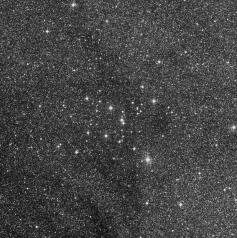This is the second of the two bright naked-eye open star clusters in the south-east portion of the constellation of Scorpius, which lies just 3.9°SW of M6. This is other cluster to my ‘Scorpio’s Sisters ’ “ the companion Butterfly Cluster. The ‘nebulous’ spot was first noted in Ptolemy’s ‘Almagest’, while Edmund Halley again catalogued it as ‘nebula’ No.29 in 1677. However, Abbe Lacaille was the first to telescopically discover true stellar nature cluster in 1755. Its first fame came when NGC6475 was listing in 1764 in Messier’ deep-sky catalogue, and remains the furthest southern object in his entire list!
NGC 6475 as a cluster unusually does not have a common or proper name, though it is actually brighter than its neighbour, M6. Telescopically this is an impressive object, worthy of low-magnification and a wide-field eyepiece. Even in binoculars it is wonderful. The total number of members is about fifty (50) blue-white (B0-B5) stars, all within the apparent diameter is about 1°. Total visual magnitude of the cluster is 3.2 to 3.3, with the brightest star around magnitude 5.6.
The Shapley classification is type ‘e’, or ‘II 2 r’. Within the cluster is an bright orange-red star, which is the double star SEE 342 (6.4 / 6.5 40″ 244° (1996)). SEE 342 was unresolvable in most amateur telescopes in 1997, separated by less than 0.6 arcsec. If you wanted to chance seeing this pair resolved this would require good seeing and sizeable aperture.
Like its nearby cousin M6, the modern distance of M7 is estimated to be 400 pc. or 1,300 ly., some 60% further than the earlier estimates, that were stating about 240 parsecs or 720 ly. Its age has been judged from the turn-off point of its colour-magnitude diagram as 220 million years, and is twice the age of the nearby M6. More recent estimation in 1985 and 1992 suggest that its age is younger. Accordingly, such as the IAU recommended data, the age maybe as young as 128 million years.
Surround Fields
Several interesting object are close to M7. Some 2.1° due east is the globular star cluster, NGC 6453. This is a fairly easy globular to spot, whose magnitude is 10.2 and has a small hazy diameter of 3.5 arcmin. The globular is hard to resolve indicating that it is fairly condensed, and has the Shapley type is IV or 4. Another is the eclipsing variable star, V907 Sco, which is due west by about 2.0° of M7, whose magnitude have been found to vary between 8.6 to 9.2. A moderately short period of 3.776 days has been determined. V907 Sco has an AO spectral type indicating a surface temperatures of 10,200K.




